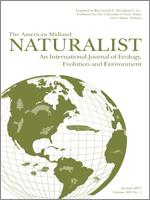Rafinesque's big-eared bats (Corynorhinus rafinesquii; RBEB) and southeastern myotis (Myotis austroriparius; SEM) are species of concern whose current population statuses are unknown. Bottomland hardwood forests are important roosting habitat for RBEB and SEM; however, ≥80% of these forests have been cleared or degraded in Mississippi. Limited information on roost site requirements exists across either species ranges; therefore, we conducted roost surveys for RBEB and SEM in bottomland and riparian hardwood forests on Noxubee National Wildlife Refuge, Legion State Park, and Tombigbee National Forest, Mississippi, during winter 2009–2010 and spring 2010. To compare seasonal roost selection for each species we compared tree species, used 95% confidence intervals (CIs) for three tree variables [diameter at breast height (DBH), cavity volume, and opening area] and logistic regression for four landscape variables (elevation, slope, distance to nearest stream, and distance to nearest road). We used Akaike's Information Criteria corrected for small sample size and model averaging to incorporate model selection uncertainty into parameter estimates of landscape models. Based on 95% CIs, RBEB and SEM in winter used trees with greater DBH and SEM used trees with larger cavities. However, during spring, RBEB and SEM occupied trees with comparable DBH and cavity size to unoccupied trees. At the landscape scale, RBEB used roost trees at lower elevations during winter and spring. During spring, SEM used trees further from roads (Importance weight = 0.76) at lower elevations (Importance weight = 0.29) and with less slope (Importance weight = 0.25). Understanding seasonal roost site selection will improve our ability to protect habitat to ensure viable populations of these bat species.
How to translate text using browser tools
1 January 2013
Multi-scale Roost Site Selection by Rafinesque's Big-eared Bat (Corynorhinus rafinesquii) and Southeastern Myotis (Myotis austroriparius) in Mississippi
Heather L. Fleming,
Jeanne C. Jones
ACCESS THE FULL ARTICLE
It is not available for individual sale.
This article is only available to subscribers.
It is not available for individual sale.
It is not available for individual sale.





